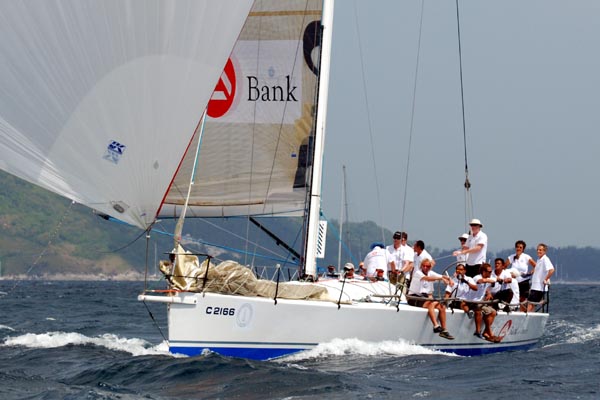Mandrake IRC 50′ Racer
Evergreen IRC 50: Gold Roman Bowl winner and top big boat Commodores Cup ’02, now winning in Asia.
The Mills Design 50′ Mandrake emerged from the 2002 Commodores Cup as the top Big Boat for the event, beating three Farr 52’s in light and shifty conditions. Her success is a testament not only to the excellent crew but to the commitment to keeping the boat up to speed shown by her experienced owner Peter Morton. She arrived for the 2002 season with a new carbon swept spreader mast from Formula Spars (see below), which increased her spinnaker area by almost 40%, ensuring a better all-around performance profile relative to the original alloy IOR rig. Her increased pace offwind, especially in the light has complemented her excellent upwind speed, and the simplified rig with 2 swept spreaders and no runners or checks has made her more competitive than ever under IRC, extending her winning lifespan.
When Peter Morton phoned in May 1999 and described what he wanted, and how long there was to complete it, it was clear that a great opportunity was available to pull off something special. A huge coup for Mills Design to be selected by such a prominent owner (his Grand Prix IMS 50 Venture 99 for the 1999 British Admirals Cup Team was being completed only a mile from the Elephant Boatyard where Mandrake took shape), and a chance for us to climb up the learning curve into true Big Boat territory. Morton had an older IOR 50 Mandrake which was in beautiful condition but by now an objectively slow boat. He wanted to use all the outstanding high tech gear, titanium parts, light alloy rig, carbon rudder, carbon/nomex deck etc, and put a new hull underneath with a minimum of delay and even less expense! The unusual stability and refinement of the IOR 50 footers meant that the recycled parts needed remarkably little modification to suit a new IRC/IRM design. Design work began in mid May, and she was racing in Cowes Week in the first week of August, the first IRM inspired design ever. Mandrake was launched and went for her first sail two days before her maiden event, to provide the new rule with an exhilarating test bed and showpiece.
The proof of her phenomenal performance was seen in that Winter Series where she won Class 1 under the more conservative IRC rule prompting this press release: “Mandrake, the IRM 50 footer from Mills Design, won Class 1 of the 1999 Hamble River Winter Series in style when she triumphed in the last and windiest race of the 8 race series. Beating 44 other entries in the unusually large class, Mandrake proved she is a real all-rounder with a final tally of 1, 1, 1, 1, 3, 5, with wins in a number of races which never saw more than 10 knots of breeze as well as dominating the final race in 20-25, recording a peak speed of 17.5 knots on the final close reach. “This really proves how quick this style of design is in all conditions” enthused designer Mark Mills. That victory brought to 5 the number of class wins from Mills Design yachts in Winter and Spring Series events since 1997, a remarkable record.”
The mid-tech hull was built using a novel foam and cedar core method. At the beginning of the project Richard Faulkner, co-builder of the boat with the Elephant Boatyard suggested a cedar strip hull under the waterline, with the flat topsides laid up in foam sandwich. The cedar is very fast to lay, and the flat topsides accepted the foam panels with minimal need for shaping. With engineering for this new and untried method from John Fox the plan went smoothly, and the hull was finished in record time. It combines with the high tech deck and bulkheads to create a very stiff structure with minimal compromise. The designs light displacement allied with high stability is a potent combination for high performance. The hull shape combines fine waterlines forwards for speed in waves with balanced sections aft for offwind speed. By keeping the waterline beam to a minimum and using rounded sections both wavemaking and frictional resistance is lowered making for a yacht with strong all-around performance. The large bulb on a laminar flow fin assures high stability as the boat heels offering excellent performance upwind as well making full use of the long waterline length.

Retro 41
Launched in Slovenia for a U.S. client, this performance design combines the casual elegance of an

Cayman 28
The Cayman 28 is an all-carbon sportsboat drawn for an experienced Cayman Islands sailor to race

Flying Nikka
The challenge set for us by repeat client Roberto Lacorte for Flying Nikka was not just to have a

IC37 by Melges
The first IC37 has hit the water to rave reviews. Hull 001 was out sailing within 24 hours of her

MD75 by Mills
‘Karma’ the first MD75 by Mills has just hit the water and is already turning heads with its

wallycento Tango
Mills Design is excited to have been chosen to design Tango, the next high performance Wally 100

Cape 31 One Design
The Cape 31 was defined from the outset as a simple clean high performance One Design without

Vismara 50 Mills
The Vismara 50 Mills is our third collaboration with the progressive Italian yard Vismara

Premier IRC 45
Concubine, the first of our latest PCT 45 IRC racing design from Premier Composite Technologies in

Vismara 56 Mills
Our latest collaboration with Vismara Marine is the Vismara 56 Mills high performance cruiser



